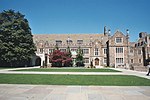Duke University Pratt School of Engineering

The Pratt School of Engineering is located at Duke University in the United States. The school's associated research, education, alumni and service-to-society efforts are collectively known as Duke Engineering. Research expenditures at Duke Engineering exceed $88 million per year. Its faculty is highly ranked in overall research productivity among U.S. engineering schools by Academic Analytics. More than 30 Duke alumni and faculty have been elected to the prestigious National Academy of Engineering since its founding in 1964.The Pratt School of Engineering also maintains these academic departments: Biomedical Engineering Civil & Environmental Engineering Electrical & Computer Engineering Thomas Lord Department of Mechanical Engineering & Materials ScienceThe school was created by Duke's Board of Trustees in 1939. It was named in 1999 following a $35 million gift by Edmund T. Pratt Jr., a 1947 graduate and former chief executive of Pfizer. The Duke University Pratt School of Engineering celebrated its 75th anniversary in 2014–2015.
Excerpt from the Wikipedia article Duke University Pratt School of Engineering (License: CC BY-SA 3.0, Authors, Images).Duke University Pratt School of Engineering
Kent Street, Durham
Geographical coordinates (GPS) Address Nearby Places Show on map
Geographical coordinates (GPS)
| Latitude | Longitude |
|---|---|
| N 36.004 ° | E -78.9403 ° |
Address
Duke University
Kent Street
27708 Durham
North Carolina, United States
Open on Google Maps





